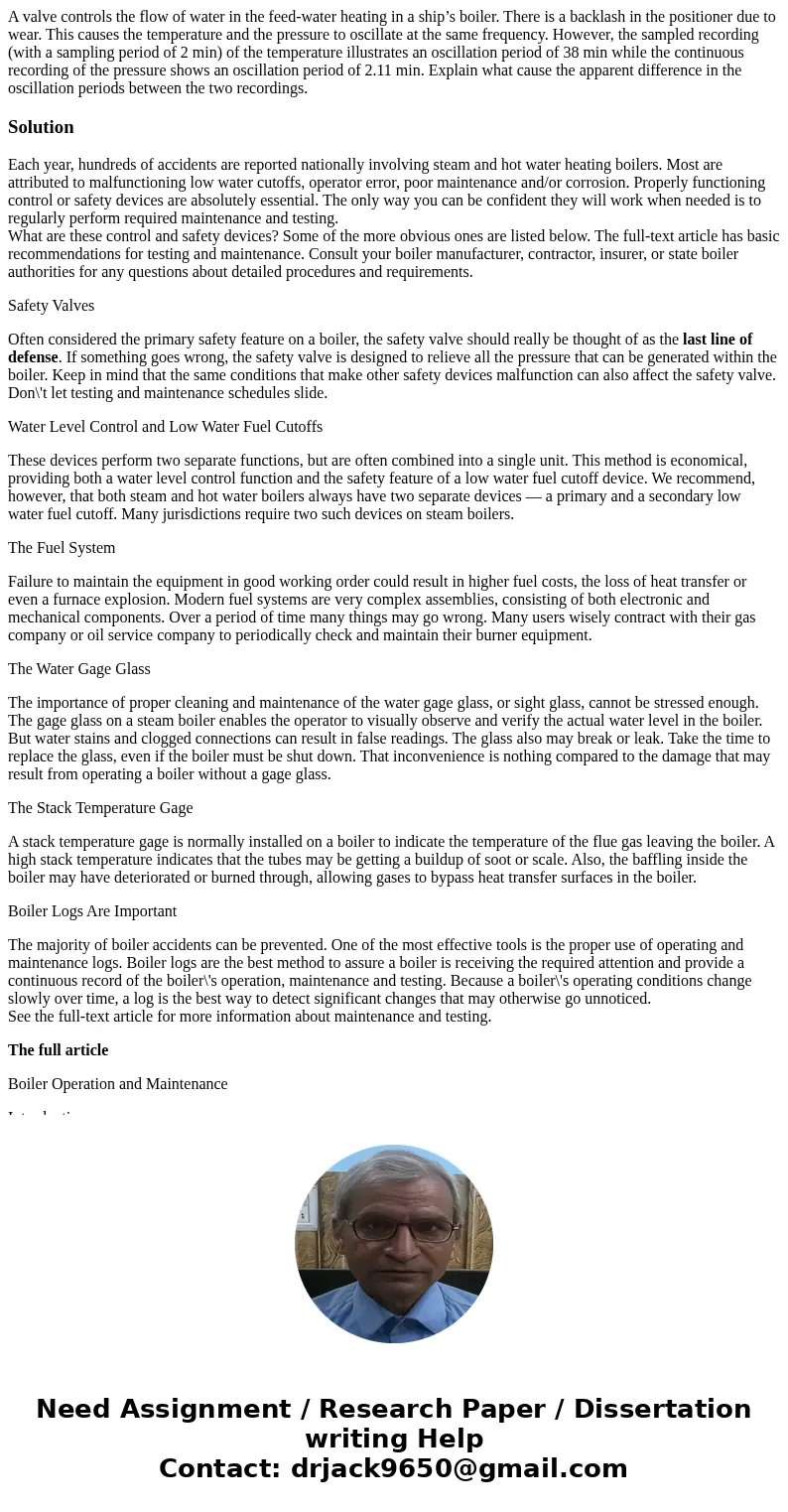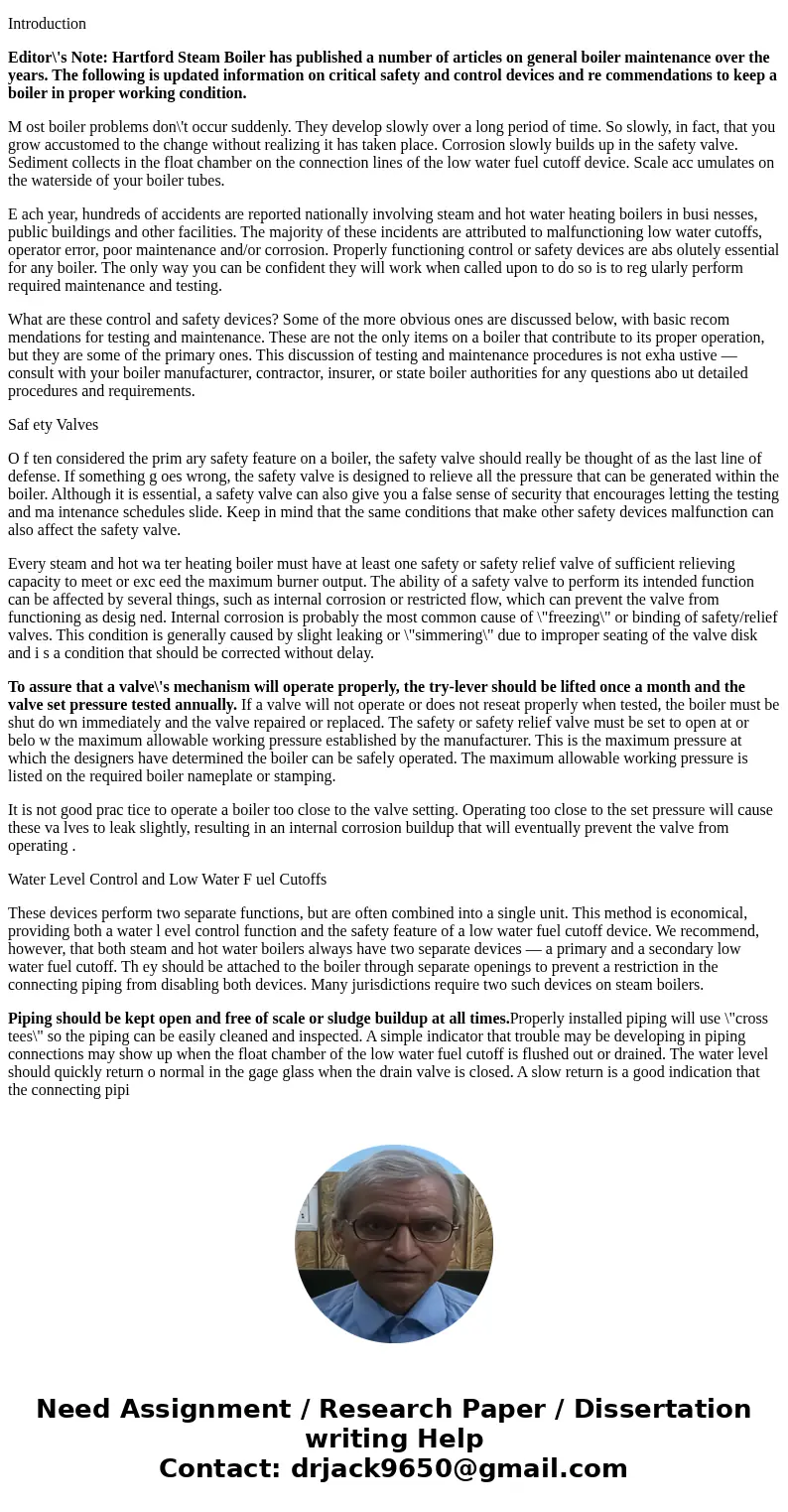A valve controls the flow of water in the feedwater heating
A valve controls the flow of water in the feed-water heating in a ship’s boiler. There is a backlash in the positioner due to wear. This causes the temperature and the pressure to oscillate at the same frequency. However, the sampled recording (with a sampling period of 2 min) of the temperature illustrates an oscillation period of 38 min while the continuous recording of the pressure shows an oscillation period of 2.11 min. Explain what cause the apparent difference in the oscillation periods between the two recordings.
Solution
Each year, hundreds of accidents are reported nationally involving steam and hot water heating boilers. Most are attributed to malfunctioning low water cutoffs, operator error, poor maintenance and/or corrosion. Properly functioning control or safety devices are absolutely essential. The only way you can be confident they will work when needed is to regularly perform required maintenance and testing.
What are these control and safety devices? Some of the more obvious ones are listed below. The full-text article has basic recommendations for testing and maintenance. Consult your boiler manufacturer, contractor, insurer, or state boiler authorities for any questions about detailed procedures and requirements.
Safety Valves
Often considered the primary safety feature on a boiler, the safety valve should really be thought of as the last line of defense. If something goes wrong, the safety valve is designed to relieve all the pressure that can be generated within the boiler. Keep in mind that the same conditions that make other safety devices malfunction can also affect the safety valve. Don\'t let testing and maintenance schedules slide.
Water Level Control and Low Water Fuel Cutoffs
These devices perform two separate functions, but are often combined into a single unit. This method is economical, providing both a water level control function and the safety feature of a low water fuel cutoff device. We recommend, however, that both steam and hot water boilers always have two separate devices — a primary and a secondary low water fuel cutoff. Many jurisdictions require two such devices on steam boilers.
The Fuel System
Failure to maintain the equipment in good working order could result in higher fuel costs, the loss of heat transfer or even a furnace explosion. Modern fuel systems are very complex assemblies, consisting of both electronic and mechanical components. Over a period of time many things may go wrong. Many users wisely contract with their gas company or oil service company to periodically check and maintain their burner equipment.
The Water Gage Glass
The importance of proper cleaning and maintenance of the water gage glass, or sight glass, cannot be stressed enough. The gage glass on a steam boiler enables the operator to visually observe and verify the actual water level in the boiler. But water stains and clogged connections can result in false readings. The glass also may break or leak. Take the time to replace the glass, even if the boiler must be shut down. That inconvenience is nothing compared to the damage that may result from operating a boiler without a gage glass.
The Stack Temperature Gage
A stack temperature gage is normally installed on a boiler to indicate the temperature of the flue gas leaving the boiler. A high stack temperature indicates that the tubes may be getting a buildup of soot or scale. Also, the baffling inside the boiler may have deteriorated or burned through, allowing gases to bypass heat transfer surfaces in the boiler.
Boiler Logs Are Important
The majority of boiler accidents can be prevented. One of the most effective tools is the proper use of operating and maintenance logs. Boiler logs are the best method to assure a boiler is receiving the required attention and provide a continuous record of the boiler\'s operation, maintenance and testing. Because a boiler\'s operating conditions change slowly over time, a log is the best way to detect significant changes that may otherwise go unnoticed.
See the full-text article for more information about maintenance and testing.
The full article
Boiler Operation and Maintenance
Introduction
Editor\'s Note: Hartford Steam Boiler has published a number of articles on general boiler maintenance over the years. The following is updated information on critical safety and control devices and re commendations to keep a boiler in proper working condition.
M ost boiler problems don\'t occur suddenly. They develop slowly over a long period of time. So slowly, in fact, that you grow accustomed to the change without realizing it has taken place. Corrosion slowly builds up in the safety valve. Sediment collects in the float chamber on the connection lines of the low water fuel cutoff device. Scale acc umulates on the waterside of your boiler tubes.
E ach year, hundreds of accidents are reported nationally involving steam and hot water heating boilers in busi nesses, public buildings and other facilities. The majority of these incidents are attributed to malfunctioning low water cutoffs, operator error, poor maintenance and/or corrosion. Properly functioning control or safety devices are abs olutely essential for any boiler. The only way you can be confident they will work when called upon to do so is to reg ularly perform required maintenance and testing.
What are these control and safety devices? Some of the more obvious ones are discussed below, with basic recom mendations for testing and maintenance. These are not the only items on a boiler that contribute to its proper operation, but they are some of the primary ones. This discussion of testing and maintenance procedures is not exha ustive — consult with your boiler manufacturer, contractor, insurer, or state boiler authorities for any questions abo ut detailed procedures and requirements.
Saf ety Valves
O f ten considered the prim ary safety feature on a boiler, the safety valve should really be thought of as the last line of defense. If something g oes wrong, the safety valve is designed to relieve all the pressure that can be generated within the boiler. Although it is essential, a safety valve can also give you a false sense of security that encourages letting the testing and ma intenance schedules slide. Keep in mind that the same conditions that make other safety devices malfunction can also affect the safety valve.
Every steam and hot wa ter heating boiler must have at least one safety or safety relief valve of sufficient relieving capacity to meet or exc eed the maximum burner output. The ability of a safety valve to perform its intended function can be affected by several things, such as internal corrosion or restricted flow, which can prevent the valve from functioning as desig ned. Internal corrosion is probably the most common cause of \"freezing\" or binding of safety/relief valves. This condition is generally caused by slight leaking or \"simmering\" due to improper seating of the valve disk and i s a condition that should be corrected without delay.
To assure that a valve\'s mechanism will operate properly, the try-lever should be lifted once a month and the valve set pressure tested annually. If a valve will not operate or does not reseat properly when tested, the boiler must be shut do wn immediately and the valve repaired or replaced. The safety or safety relief valve must be set to open at or belo w the maximum allowable working pressure established by the manufacturer. This is the maximum pressure at which the designers have determined the boiler can be safely operated. The maximum allowable working pressure is listed on the required boiler nameplate or stamping.
It is not good prac tice to operate a boiler too close to the valve setting. Operating too close to the set pressure will cause these va lves to leak slightly, resulting in an internal corrosion buildup that will eventually prevent the valve from operating .
Water Level Control and Low Water F uel Cutoffs
These devices perform two separate functions, but are often combined into a single unit. This method is economical, providing both a water l evel control function and the safety feature of a low water fuel cutoff device. We recommend, however, that both steam and hot water boilers always have two separate devices — a primary and a secondary low water fuel cutoff. Th ey should be attached to the boiler through separate openings to prevent a restriction in the connecting piping from disabling both devices. Many jurisdictions require two such devices on steam boilers.
Piping should be kept open and free of scale or sludge buildup at all times.Properly installed piping will use \"cross tees\" so the piping can be easily cleaned and inspected. A simple indicator that trouble may be developing in piping connections may show up when the float chamber of the low water fuel cutoff is flushed out or drained. The water level should quickly return o normal in the gage glass when the drain valve is closed. A slow return is a good indication that the connecting pipi


 Homework Sourse
Homework Sourse